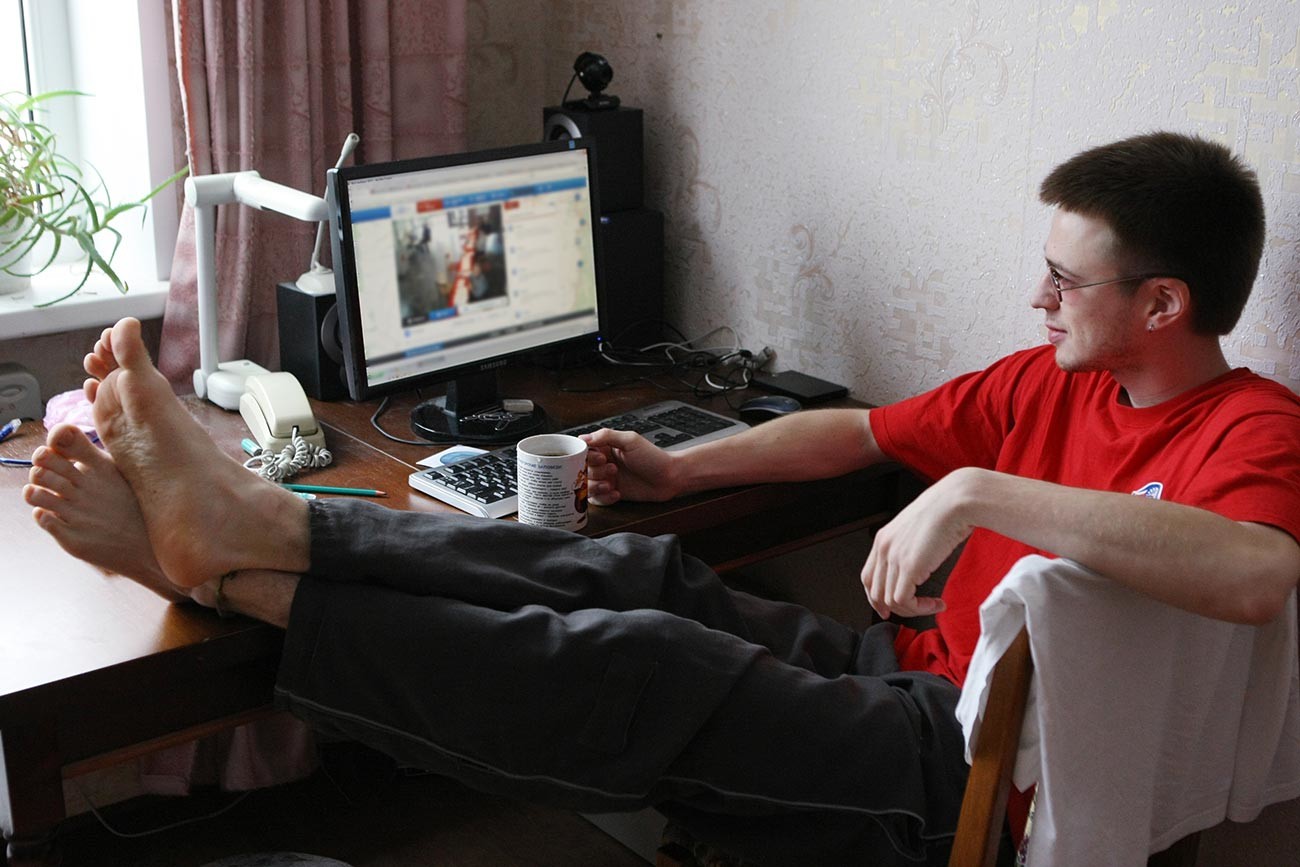Welcome to the world of Russian trash streams, where people get insulted and bullied for money

Warning: The text below contains a description of scenes of humiliation and violence. In publishing it, Russia Beyond in no way condones such behavior, but merely seeks to contribute to the debate surrounding Russian trash streams. Those of a nervous disposition are recommended not to read further.
An intoxicated young guy with tattooed arms and two girls sit in a small well-lit room in a private house in the Moscow Region; an unfinished bottle of whiskey is on the table; a sign reads: “Drink whiskey — 200 rubles [$3], French kiss — 1,000 rubles [$13.6].”
“Which of us is top?” one of the girls, who has bright pink hair, asks the man.
“Marinka's definitely top,” he replies, pointing to her friend.
The pink-haired lady, furious at the reply, rushes at the guy with her fists, but after a minute falls to the floor and disappears from the screen. After another couple of minutes, you can hear her screaming “Get me a cab!”; then the stream goes dead for several hours.

When filming resumes, we see the streamer dragging the already dead, half-naked woman across the floor, shakes her, strokes her hair and, with tearful eyes, tells her to wake up. He then takes questions from viewers, while the corpse lies in the background. The guy films the conversation with the ambulance crew that arrives.

“The problem was she shit her pants. Don’t know why. <...> It really stank,” he says to a paramedic.
“Is that why you kicked her out?” asks the latter.
"Yes." <…>
“Tell everyone that you threw her out, and that’s why she died,” says the paramedic.

That was the night of Dec. 1-2, 2020, during a stream by Stas Reshetnikov, known as Reeflay or Panini, a Russian-speaking blogger who creates and monetizes broadcasts, which in Russia are called trash streams.
According to the police investigation, the woman suffered a closed head injury and multiple bruising. On Dec. 4, 2020, a court in Moscow’s Ramensky District sentenced the blogger to two months imprisonment. Later, his lawyer Yevgeny Kulagin told news agency RIA Novosti that Reshetnikov was not to blame for the woman's death, claiming that she had died of a "spontaneous cerebral hemorrhage."

Nevertheless, following this incident, the Federation Council (Russia’s upper house of parliament) proposed a ban on trash streams. How do these streams work, what other gruesome things happen, and who is willing to pay to watch it live?
Violent online parties
Most Russian-speaking trash streamers appeared on Twitch, and later on YouTube, in the early 2010s. Almost all initially did game streaming, but due to low viewing figures and donations they decided to change the format.
Kirill Zyryanov (alias Vjlink) from Odintsovo, Moscow Region, is one of them. During a stream in 2013, he had a live drunken fight with a friend, lost a tooth, and became wildly popular as a result. Kirill continued his alcohol-infused streams, and soon began to perform dares for money from subscribers, including one in which he broadcast an operation to enlarge his penis (the organ itself was blurred). The blogger insisted that the video was exclusively for medical research purposes, yet the footage remains on YouTube to this day. The live stream was watched by 90,000 people.

Trash streams are usually broadcast from parties in the style of the 2012 movie Project X, but with extra humiliation and violence. During such "parties," viewers pay 50-200 rubles ($0.70 – $2.70) to trash one of the participants. For more money, streamers are ready, among other things, to beat someone up, paint themselves luminous green, douse themselves in urine, or extinguish cigarettes on their body.
Streamers share the earnings when completing tasks with other participants. Here’s what blogger Andrei Burim (alias Mellstroy) did: he invited women to parties in Moscow-City and offered money for completing various tasks. During a stream in October 2020, he repeatedly slammed one woman headfirst into a table, after which YouTube blocked his channels, and the police opened a criminal case. The blogger continues to stream on backup channels, as well as publish content on Telegram — mostly photos and videos with half-naked girls.

Another trash streamer, Ivan Pozharnikov, mocks homeless people for donations: he hits them with a ladle over the head, feeds them pet food, and makes them fight each other. In the channel description, Ivan says that his aim is to re-educate the homeless. Of the trash streamers mentioned in this article, he is the only one who responded to Russia Beyond’s request for an interview, but only for money.
One of the most popular “victims” is 32-year-old Yaroslavl native, Valentin Ganichev, who takes part in various streams in which he is bombarded with eggs, doused with cold water, forced to eat slops, and even buried alive. During most streams, Valentin is drunk or out of his mind on drugs, and often cries and pleas for help. Viewers were so sure that the streamers were doing it against Valentin’s will that the police investigated. However, Valentin himself later confirmed that he is a volunteer, according to RIA Novosti.

YouTube and Twitch occasionally block channels showing such things, but streamers are adept at using backup channels, and fans upload content to Telegram and various file hosting services.
One more trash blogger, Andrei Yashin from Chelyabinsk, streams on YouTube together with his mother Lyudmila for 20,000 rubles ($270) per broadcast. He once kissed her live on air (not on the cheek), and in late 2019, during a quarrel, punched her in the face. After the police came round, Yashin recorded a video apology and explained that the fight was for PR purposes; the police dropped the case.
Contrasting views
“They should all be locked up, except for Valentin, who’s mentally ill. It’s nothing but sadism in the highest degree,” is what regular viewer, 25-year-old security guard Anton says about trash streams.
He started watching them during work shifts out of sheer boredom.
“I was attracted by the real, not faked emotions. You can watch it endlessly, it’s just like real life,” Anton is sure.
Sixteen-year-old schoolgirl Polina also criticizes trash streams for excess cruelty. According to her, despite the bad taste, they used to be funnier.

“Two years ago there were lots of funny jokes about, for example, the death of one of the participant’s mothers. Such streams reveal people’s true nature, what they’re ready to do for money,” says Polina. The deceased mother in question belonged to the aforementioned Valentin Ganichev.
Stream viewers sent donations with comments saying that it was his mother communicating from the other world, causing Valentin to break down in sobs. According to Polina, it was funny.

Another viewer, 19-year-old Nikita, claims that watching streams makes him feel part of a big hangout — he can ask or tell streamers anything, and they’re very likely to respond.
A fan of trash streams nicknamed xbpm_music, located in Germany, claims that he senses something “inherently Russian” in trash-stream participants, and that such live broadcasts help him not to pine so much for his homeland.
“It's fun for me to see typical Russian idiots. Sometimes I look at them and think: ‘Damn, I really need to do something good, otherwise I’ll become like them.’ Motivation or what?” he philosophizes.
Armchair boxers and the future of trash streaming
Getting pleasure from watching violence is a mental disorder, says practicing psychologist Alena Al-As. In her opinion, streamers satisfy both their own need for savagery and that of their audience.
“The average viewer is an armchair boxer who would probably beat his wife, but knows that she would go to the police. Plus, on the other side of the screen are often people who have been beaten and humiliated in real life. Understanding that ‘I’m not the only one with a grievance’ helps many to crawl out of the pit of despair,” explains the psychologist.
According to another psychologist, Lyubov Kalinovskaya, viewers vicariously realize their ambitions through trash streams. She is sure that the main participants in trash streams are in fact the viewers, since they can control the actions of popular bloggers with donations.

“For many, trash streams are unique because they guarantee reality, and no one ever knows how it will end. That creates a thrill for the viewer, like ancient Romans enjoyed deciding the fate of a defeated gladiator,” says Kalinovskaya.
As for psychologist and business consultant Alex Ayvengo, he is sure that such broadcasts have no therapeutic effect, and only make both viewers and streamers even more violent.
“Trash streams hook viewers and make them demand more and more. The ‘ideal’ ending is a brutal death, rape or mockery of a corpse live on air. It probably won’t be long before we see a professional studio production, shot from a first-person perspective, allowing the viewer to ‘try on’ the role of the murderer or victim, not just be a watcher,” believes Ayvengo.
If using any of Russia Beyond's content, partly or in full, always provide an active hyperlink to the original material.
Subscribe
to our newsletter!
Get the week's best stories straight to your inbox